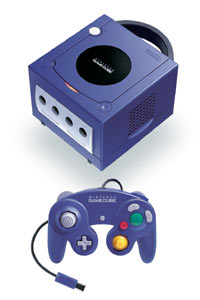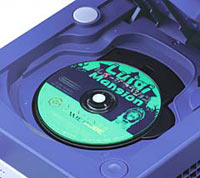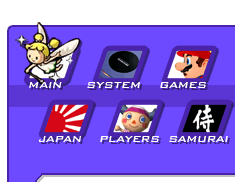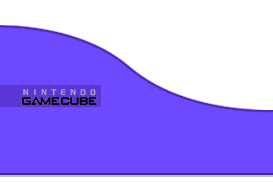 |

NINTENDO GAMECUBE
Microprocessor Unit (MPU)
IBM Power PC "Gekko"
Manufacturing process: 0.18 Microns Copper Wire Technology
Clock frequency: 485 MHz
CPU capacity: 1125 Dmips (Dhrystone 2.1)
Internal data precision: 32-bit integer & 64-bit floating point
External bus bandwidth: 1.3 GB/second (peak), (32-bit address space, 64-bit data bus 162 MHz)
Internal cache: L1: Instruction 32 KB, Data 32 KB (8 way), L2: 256 KB (2 way)
System LSI
"Flipper" - 110 mm2, 51 millions transistors, primarily developed by ATI, ArtX, NCL and NTD.
Manufacturing process: 0.18 microns NEC Embedded DRAM Process
Clock frequency: 162 MHz
Embedded RGB buffer: Approx. 1 MB, sustainable latency: 6.2 ns (1T-SRAM)
Embedded Z buffer: Approx. 1 MB, sustainable latency: 6.2 ns (1T-SRAM)
Embedded texture cache: Approx. 1 MB, sustainable latency: 6.2 ns (1T-SRAM)
Texture read bandwidth: 10.4 GB/second (peak)
Main memory bandwidth: 2.6 GB/second (peak)
Pixel depth: 24-bit Color, 24-bit Z Buffer
Image processing function: Fog, subpixel anti-aliasing, 8 hardware lights, alpha blending, virtual texture design, multi-texturing, bump mapping, environment mapping, MIP mapping, bilinear filtering, trilinear filtering, anisotropic filtering, real-time hardware texture decompression (S3TC), real-time decompression of display list, HW 3-line deflickering filter.
Simultaneous textures: 8
System floating point arithmetic capability: 10.5 GFLOPS (peak) (MPU, Geometry Engine, HW Lighting Total)
Real-world polygon: 6 millions to 12 millions polygons/second (display capability assuming actual game conditions with complexity model, fully texture, fully lit, etc.)
Examples of display capability: (All examples with fog, z-buffer and alpha blending effects)
Feature 1 vertex color + 1 light + 1 texture: 25 millions polygons/second.
Feature no vertex color + 1 texture: 33 millions polygons/second.
Feature 1 vertex color + no texture (Gouraud Shading): 40 millions polygons/second.
Estimated raw display capability: 90 millions polygons per second.
Fill rate: 800 millions pixels.
Sound processor: Macronix 16bit DSP
Instruction memory: 8KB RAM + 8KB ROM
Data memory: 8KB RAM + 4KB ROM
Clock frequency: 81 MHz
Performance: 64 simultaneous channels, ADPCM encoding
Sampling frequency: 48 KHz
System memory: 40 MB
Main memory "Splash": 24 MB sustainable latency, (10 ns or lower 1T-SRAM)
A-Memory: 16 MB (81 MHz DRAM) expandable to 48 MB with an external accessory
 Other
Other
Disc drive: CAV (Constant Angular Velocity) System
Average access time: 128 ms
Data transfer speed: 16 Mbps to 25 Mbps
Media: 8 cm (3 inch) Nintendo GameCube Disc based on Matsushita's optical disc technology - approximately 1.5 GB capacity
Input: Controller port (x4), Memory card Digicard slot (x2), Analog AV output (x1), Digital AV output (x1), High-speed serial port (x2), High-speed parallel port (x1)
Power supply: AC Adapter DC12V x 3.5A
Main unit dimensions: 150mm(W) x 110mm(H) x 161mm(D) - 5.9"(W) x 4.3"(H) x 6.3"(D)
Additional pictures:
- top picture (GameCube and controller) in giant size
- comparison between GameCube's first known design and the final design
(image montage by Samurai Nintendo)
|
 |









